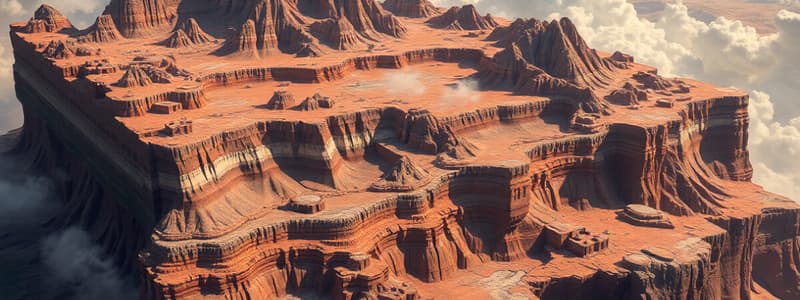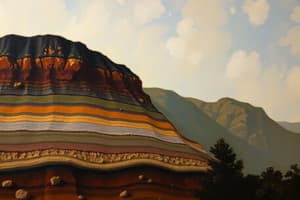Podcast
Questions and Answers
What are the three compositional layers of Earth's interior?
What are the three compositional layers of Earth's interior?
- Lithosphere, asthenosphere, mesosphere
- Crust, mantle, outer core
- Crust, mantle, core (correct)
- Inner core, outer core, lithosphere
What is a primary reason scientists have not collected samples from Earth's core?
What is a primary reason scientists have not collected samples from Earth's core?
- There are no known methods for deep drilling
- The core is solid and cannot be reached
- It is too deep and extremely hot (correct)
- It's too far and expensive to reach
Which layer is NOT part of the structural model of Earth?
Which layer is NOT part of the structural model of Earth?
- Crust (correct)
- Lithosphere
- Outer core
- Mantle
How do scientists study the outer layers of Earth?
How do scientists study the outer layers of Earth?
Why is the mantle denser than the crust?
Why is the mantle denser than the crust?
What distinguishes the lithosphere from the crust?
What distinguishes the lithosphere from the crust?
What is one of the challenges in studying the mantle directly?
What is one of the challenges in studying the mantle directly?
What are undifferentiated stony meteorites believed to originate from?
What are undifferentiated stony meteorites believed to originate from?
What causes convection in the Earth's outer core?
What causes convection in the Earth's outer core?
Why are most fossils found in sedimentary rocks?
Why are most fossils found in sedimentary rocks?
What characterizes soft-part preservation in fossils?
What characterizes soft-part preservation in fossils?
Which process involves organisms becoming trapped and preserved in resin?
Which process involves organisms becoming trapped and preserved in resin?
What is a cast in terms of fossilization?
What is a cast in terms of fossilization?
What types of fossils provide evidence of an organism's behavior or activity?
What types of fossils provide evidence of an organism's behavior or activity?
In which environment is soft-part preservation most likely to occur?
In which environment is soft-part preservation most likely to occur?
What primarily shapes Earth's surface through weathering and erosion?
What primarily shapes Earth's surface through weathering and erosion?
Flashcards
What are the three compositional layers of Earth's interior?
What are the three compositional layers of Earth's interior?
The three layers of Earth based on their chemical composition are the crust, mantle, and core.
Why haven't scientists collected samples from Earth's core?
Why haven't scientists collected samples from Earth's core?
It's too hot and deep to reach! Plus, the immense pressure would crush any sampling device.
What are the key differences between the compositional and structural models of Earth's interior?
What are the key differences between the compositional and structural models of Earth's interior?
The structural model classifies layers based on physical properties (temperature, flow), while the compositional model focuses on their chemical makeup and what they are made of.
What is the lithosphere and how is it different from the crust?
What is the lithosphere and how is it different from the crust?
Signup and view all the flashcards
How do scientists study the outer layers of Earth?
How do scientists study the outer layers of Earth?
Signup and view all the flashcards
Why is the mantle denser than the crust?
Why is the mantle denser than the crust?
Signup and view all the flashcards
What challenges are there in studying the mantle directly?
What challenges are there in studying the mantle directly?
Signup and view all the flashcards
Why are some stony meteorites undifferentiated?
Why are some stony meteorites undifferentiated?
Signup and view all the flashcards
Convection in Earth's Mantle
Convection in Earth's Mantle
Signup and view all the flashcards
Soft-Part Preservation
Soft-Part Preservation
Signup and view all the flashcards
Trace Fossils
Trace Fossils
Signup and view all the flashcards
Replacement Fossil Formation
Replacement Fossil Formation
Signup and view all the flashcards
Body Fossils
Body Fossils
Signup and view all the flashcards
Cast Fossil Formation
Cast Fossil Formation
Signup and view all the flashcards
Processes Shaping Earth's Surface
Processes Shaping Earth's Surface
Signup and view all the flashcards
Fossil Formation in Sedimentary Rocks
Fossil Formation in Sedimentary Rocks
Signup and view all the flashcards
Study Notes
Earth's Interior Composition and Structure
- Earth's interior has three compositional layers: crust, mantle, and core.
- The core is extremely deep and incredibly hot, making direct sampling impossible.
- Deep layers are hotter.
Comparing Compositional and Structural Models
- Structural Model: This model focuses on physical properties (like temperature, rigidity, flow) of Earth's layers. Layer names include lithosphere, asthenosphere, mesosphere, outer core, and inner core.
- Compositional Model: This model focuses on chemical composition (minerals, rocks) of Earth's layers. Layer names include crust, mantle, and core.
Crust vs. Lithosphere
- Similarities: Both can be studied through earthquakes and volcanic eruptions.
- Differences: The crust is the outermost layer of Earth. The lithosphere includes the crust and upper rigid mantle.
Mantle Study Challenges
- Directly studying the mantle is difficult due to its great depth.
- Undifferentiated stony meteorites offer clues. These are small objects that cooled and solidified so fast, they didn't completely separate into distinct layers by density.
Earth's Mantle and Crust Density
- The mantle is denser than the crust due to a higher proportion of heavier elements and compression caused by the crust's weight.
Earth's Internal Structure and Convection
- Earth's inner layers are primarily heavier elements. Outer layers have a wide variety of elements in their rocks.
- Convection in Earth's outer core and mantle is driven by temperature differences. Hotter, less dense materials rise, cooler, denser materials sink, creating a circulation pattern (convection cells).
- Inner core doesn't convect due to its high pressure despite high temperature.
Processes Shaping Earth's Surface
- Processes include weathering, erosion, and both solar and internal energy.
Fossil Formation and Preservation
- Most fossils are found in sedimentary rocks, as water buries organic remains.
- Body Fossils: These are the actual remains of organisms.
- Replacement: Organisms are buried and become replaced with minerals, forming fossils.
- Casts, Molds, and Imprints: These structures are formed when a decay remains of organism produces a three-dimensional mark.
- Soft-Part Preservation: Requires specific environments for preservation of non-mineralized tissues (e.g., poor acidity).
- Trace Fossils: Signs of an organism's activity (like footprints).
Studying That Suits You
Use AI to generate personalized quizzes and flashcards to suit your learning preferences.




